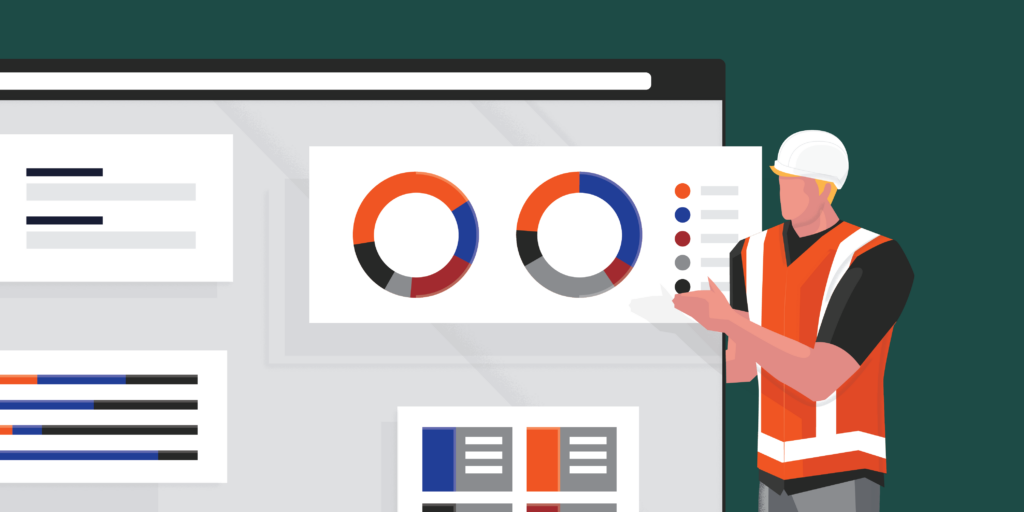— 21 min read
Construction Management & The Role of a Construction Manager
Last Updated Jun 6, 2024
Last Updated Jun 6, 2024

Whether you’re just starting out in the industry or you’re an open-minded expert who wants to know how the role has changed and will continue to do so in this new decade, this definitive guide provides an overview of everything you need to grow as a construction manager.
Table of contents
What Is Construction Management?
Construction management is a specialized field of project management that involves supervision and coordination of construction activities to ensure successful project delivery. The term can also refer to a field of study: Many colleges and universities offer degree programs in construction management.
Relationship to Other Project Stakeholders
To fully understand how construction managers ensure successful projects, let’s put it within the context of the four various project stakeholders in the construction job title hierarchy.
The Owner: An individual or business entity who commissions and funds a project. Owners come from many different industries—real estate, development, healthcare, education, and more. Many don’t have dedicated construction oversight teams and choose to contract out the work to a certified construction manager.
The Construction Manager: The person or team hired by the owner to provide oversight of the entire project’s delivery — from planning and preconstruction through construction and turnover.
The Licensed Architect and/or Engineer: The person or firm hired by an owner to manage project design and technical coordination between engineering disciplines.
The General Contractor: The team hired by an owner to oversee day-to-day construction operations and subcontractor productivity during construction.
Construction Management Phases
1. Planning
You get what you plan for. Measure twice, cut once. A stitch in time saves nine.
Whichever phrase you prefer—the main lesson here is that carefully coordinated pre-planning is the first major phase of risk mitigation. During this phase, the owner defines:
- Why there is a need for a building
- What their goals and success metrics will be
- How the needs and goals will impact the design
- Scopes for budget and timeline
Simultaneously, the construction manager works with the architects, engineers, and other hired consultants to agree on the feasibility of those goals and do their best to plan ahead for potential construction setbacks.
The construction manager will also research which delivery method is most appropriate considering the task at hand. Just because design-build is the traditional way of delivering construction projects, it does not mean it is the best. In fact, the adversarial relationships engendered by design-build often add more stress, cost, and risk to project outcomes.
At best, design-build can provide owners with a fixed price contract to start with. But unless it is a traditional project with few unknowns, it is likely the price will change. This can damage relationships and lead to cut corners from contractors.
The greater the risks at the beginning, the more important it is to plan correctly around the right delivery method to avoid additional costs. Nevertheless, the greater the risks at the beginning, the greater the chance for additional costs.
2. Preconstruction
During preconstruction early plans are submitted for building permits and general contractor bids. This could include construction management contracts, drawings, and specifications.
Meanwhile, the construction manager is in charge of hiring all construction teams and utilizing risk management best practices to ensure that issues are resolved prior to the start of construction. Proper risk management minimizes the amount change orders and delays down the road.
3. Construction
Planning is done. The general contractor breaks ground. Execution begins.
During construction, the construction manager oversees:
- Quality control inspections
- Site investigations
- Monitoring general contractor safety programs
- Monitoring insurance
- Answering RFIs
- Reviewing and approving technical submittals
- Coordinating permits
- Managing the budget
- Scheduling timely payment for work completed
- Ensuring the project is delivered as designed
All of this keeps the project moving smoothly while keeping stakeholders informed and satisfied.
4. Close-Out
Punch lists are completed. Keys and as-builts are handed over to the owner.
Management of the building is officially “turned over” from the construction manager and general contractor to the owner.
The owners must be provided with all project information and close out documents such as manuals, warranties, as-builts, and closed out ledgers. Insurance must also be changed from the course of construction to permanent property insurance. And in some cases, the owner is trained on how to use and manage their facility.
Construction Project Manager Job Description & Key Functions
A construction project manager’s job description is simple when observed through the lens of the project management triangle. Summed up as “fast, good, or cheap...pick two,” the concept asserts that there are firm boundaries on what is possible to produce.
The triangle metaphor implies there is no way to provide goods or services that are simultaneously on budget, on time, and of high quality because of the competing nature of these priorities.
It’s the construction manager’s job to defy that notion and deliver all three to their owner.
To do so, they work with all parties—architects, engineers, and general contractors—and take responsibility for budget, construction management contracts, risk management planning, and management of the team to meet overall design and construction milestones. All according to the owner’s expected standards of quality, scope, and function.
Setting Project Scope
A construction project’s scope of work (SOW) generally refers to the list of obligations—what is to be built, for how much, and by when—that a contractor, subcontractor, material supplier or equipment supplier is to produce or install for the owner.
Construction Management & Scheduling
Once all initial planning and bidding has informed the project schedule, it is the construction manager's job to notify contractors of that schedule. That way general contractors can schedule labour, equipment, and materials with vendors accordingly.
As the liaison between the owner and construction, each construction manager must also delegate tasks to the rest of their team. Including estimators, surveyors, designers, and builders
Allocating Resources
In chess, grandmasters run permutations of decision trees with moves and countermoves. Allocating resources is no different.
There are 3 major types of resources in construction: labour, materials, and equipment.
Once the project scope is set, allocating the proper resources begins. This includes everything from coordinating workers to their jobsites, organizing the timely delivery of building materials, and securing equipment and tools.
Many owners, construction project managers, and general contractors work on more than one project at a time, limiting the pool of available resources at their disposal. Like a master chess player—the construction manager has to see who is available on those specific days and times, what equipment they’re going to need or purchase, and where the jobsite is.
If there’s too much coverage, the budget increases at the risk of paying people to stand around and wait for something to do. Not enough coverage, and you’ll be slowing down the build. It’s a tough balancing act, but there are tools that can help.
Coordinating Operations
Construction managers consult on which teams to hire or not based on their risk assessment, obtain work permits, troubleshoot emergencies, schedule walkthroughs, and keep the owner informed on the progress on a project.
Maintaining Communication Between Parties
Construction managers work for the owner’s interest. But other parties, like general contractors, subcontractors, and designers, are ultimately working to get paid and protect their bottom line.
When overseeing architects, surveyors, general contractors, specialty contractors, and others, it is important that all these members of the project staff are managed effectively so that everyone is working toward the same goal of producing the best work for the owner.
Systems And Tools Used In Construction Management
If you ask any risk management consultant, they’ll tell you the truth: the real silent killers aren’t nightmarish doomsday risks but the poor processes that plague a construction manager’s every day.
Common Causes of Risk
In one study, researchers analyzed the top 10 risks that are most likely to occur and have a significant impact on construction project objectives. In order of importance, they are:
- Tight project schedule
- Design variations / variations by the client
- Excessive approval procedures
- High performance and quality expectations
- Poor project management techniques
- Lack of coordination between project participants
- Unavailability of sufficient skilled professionals
- Incomplete approval and other documents
- Incomplete or inaccurate cost estimates
- General safety
Luckily, there are construction management platforms that can help create a 3,000-foot view of a project and make it easier to predict and prevent poor micro practices from infringing on project success.
Construction Management Software
In the span of a generation, many construction industry design and management processes have been transformed. Designs that used to be created and updated on drawing boards by hand are now generated and amended on computer screens, often in 3D.
The drawings themselves are no longer printed, copied, folded, and then mailed. Today, they’re sent as email attachments or shared with online collaboration platforms like Dropbox or Google Drive. And double-entry bookkeeping in traditional ledgers is now managed via Excel or industry-specific finance and accounting software like Sage or Viewpoint.
Despite all of this, the construction industry is still a long way from being truly digitally transformed. The lack of adoption and reliance on old-school, manual methods perpetuates preventable mistakes that make construction a low-margin business.
Daily Logs
Even at additional expense, technology that integrates to allow communication between workflows and departments for cross-functional teams can reduce a construction manager’s stress, optimize their use of time, save the project money, increase productivity, and minimize miscommunication.
As the main center for communication and collaboration between teams, digitizing daily logs is an impactful place to start.
RFI Logs
Requests for Information (RFIs) are upstream requests (ex: questions from GCs for their engineers, architects, or owner) for greater clarity about contractual obligations, agreements, drawings, or specifications. They take time and manpower, and are usually necessary due to the siloed nature of construction disciplines.
- Architects design the building.
- Engineers deduce how to build it safely.
- Contractors oversee the actual construction.
Operational silos like these are good and necessary. They allow for individual teams within an organization to use their specific expertise, apply it to an individual task, and take ownership and responsibility of their work.
However, these swimming lanes also create the need for information exchange and request for clarity between parties. For example, when bidding or allocating resources for a project, general contractors may have questions for the engineer about specifications that may impact the amount or quality of materials that need to be ordered from a vendor. The GCs need to wait for clarity from the engineer before proceeding at risk, which holds up the progress of a job and leads to additional costs and delayed delivery.
In an effort to monetize the costs RFIs create for construction firms, Navigent Construction Forum of Navigant Consulting, Inc. reviewed RFI data from 1,362 projects worldwide for a total of 1,083,807 RFIs. The projects ranged in value between $6.7 million (USD 5 million) and $6.7 billion (USD 5 billion), and each one had an average of 796 RFIs.
The research revealed that RFIs can create significant backlogs, since owners and project managers are required to review and respond to each individual RFI from contractors and subcontractors, noting the cost of each one and the use of the process to make claims against owners.
The study revealed that the cost of reviewing and responding to each individual RFI, can cost an average of $1,455 (USD 1,080), while the collective cost to the project could set a firm back $1,158,229 (USD 859,680).
In addition, whether due to requests not considered by the design team, questions already answered in the original contract, or because they are focused on means and methods, more than one in ten of the RFIs were listed as "unjustifiable." Collectively, these unjustified RFIs averaged about $152,781 (USD 113,400) per project.
Contractors who implement construction project management software can effectively eliminate these delays by making RFIs available to all relevant parties instantaneously.
Phone Logs
Construction managers travel often while coordinating multiple different teams and projects. Keeping records of phone logs to document processes is a best practice and form of risk management to ensure payment. Some software automatically records phone logs, meeting agendas, and minutes.
Delivery Logs
More often than not, delivery logs for materials and equipment will be managed by the jobsite superintendent, project manager, or other site manager job description on the general contractor’s team. As a lead coordinator, construction managers will need visibility into this. Digital delivery log software would make it easy for the CM to view on the go.
Labour Planning Documentation (PERT CPM)
Deadlines mean different things to different stakeholders. A practical construction manager knows that schedules are always in flux. Meanwhile, owners have their eyes on the bottom line at all times. If substantial completion isn’t met according to the contract you’ve signed, you could be at risk for a lawsuit.
Missed deadlines and project delays are one of the most common reasons for arbitration, second to only cost overruns. This is where the critical path method can help.
The Critical Path Method (CPM) allows for lists of activities to be linked in order of dependency. For example, you can’t pour cement until rebar has been set and you can’t build the second floor of a building before you’ve built the first. For these reasons, the Critical Path Method is great for proving due diligence in the unfortunate case of a delay dispute. The basics of CPM are cause and effect.
The Critical Path Method is only as powerful as the data that you enter into it. If estimates are off, or man-hours aren’t calculated correctly, you may end up with delays and cost overruns. So don’t automatically consider a CPM chart to be the ultimate truth.
Unfortunately, it overcomplicates the view of daily tasks and progression timelines for those in the field who need to take a quick glance at the status of a project. But, a properly thought out schedule allows the construction manager, contractor, and owner to coordinate the work and labour resources that are needed to complete projects in a timely manner.
The Construction Manager's Role During Each Stage of Construction
What construction managers do during each phase of construction is largely dependent on the project’s delivery method.
Project delivery methods
- Integrated Project Delivery (IPD) is a method that pulls together all project teams, from the architect to general contractor to owner and interior designer, in order to take advantage of all key stakeholder knowledge and maximize the best project outcome. IPD is the highest form of collaboration because all parties are joined by a single contract.
- In design-bid-build delivery (DBB), owners contract the design firm that produces the construction documents and the builder that physically builds the building, separately. This is the traditional method of delivery and is based on the sequential process of design, construction documents, bidding, and then construction.
- In design-build projects, “the owner manages only one contract with a single point of responsibility. The designer and contractor work together from the beginning, as a team, providing unified project recommendations to fit the owner's schedule and budget. Any changes are addressed by the entire team, leading to collaborative problem-solving and innovation, not excuses or blame-shifting. While single-source contracting is the fundamental difference between design-build and the old ways, equally important is the culture of collaboration inherent in design-build.”
Bidding
During the bidding process the construction manager consults on which contractors to hire—price is just one component of that. They are also in charge of assessing the level of risk of each contractor to ensure that all safety, financial, and insurance records don’t present any red flags about why their bid should not be accepted.
Feasibility
Feasibility studies are generally conducted during the planning process to determine if the project is viable and whether or not additional capital investment or financing is needed. Feasibility studies generally consist of land surveys, building permits, zoning laws, impact reports on the surrounding environment and natural habits, traffic issues, and general impact on businesses in the area as well as the overall market opportunity.
Pre-Construction
The construction manager is in charge of prequalifying and procuring the professional teams. This mostly consists of managing contracts and insurance, accepting bids from general contractors, assessing the level of risk of each potential general contractor, and incorporating all of their rough estimates of scope into the total project budget and schedule.
Procurement
Procurement is a process in the pre-construction phase in which the construction manager helps to acquire bids for equipment, materials, and construction services. They then technically and commercially evaluate those bids and issue purchase orders and negotiate construction contracts.
Construction
Construction managers oversee the daily operations of general contractors, specialty contractors, vendors, and other project staff. Their main goal during construction is to make sure the project runs according to schedule and budget.
Change management
On a construction project, a change event is any change that affects the original scope of a construction project. It can be any event that affects the scope of the work to be completed, causes a change to the project schedule, or results in unexpected costs.
While the quantity and scope of change orders can certainly be reduced with proper design and planning, any decent-sized project will have them. Planning for this eventuality upfront and having the proper systems and procedures in place is crucial for setting everyone up for success.
Occupancy
Occupancy is the phase in post-construction after the completion of the build and close out of all punch lists. Keys, as-builts, and other information that the owner needs to manage their new building must be handed over. The owner prepares to open doors for business.
Delegating Tasks
Allocating resources in construction is one of the biggest chess games of a construction manager’s life. As the main liaisons between the owner and construction, each construction manager delegates tasks to their team of estimators, surveyors, designers, and builders, all while orchestrating the progress of each toward one singular goal—on time, on budget, and quality builds.
Notifying Contractors Of Scheduling
Once all initial planning and bidding has informed the project schedule, general contractors need to be informed so that they can schedule labour, equipment, and materials with vendors accordingly.
Construction Manager vs. General Contractor: What’s The Difference?
Both the construction manager and general contractor job descriptions describe themselves as the head contractors on the job. Which is why it’s not surprising that many find it difficult to distinguish general contractors from construction managers.
If you’re choosing between a career as a construction manager vs general contractor, this can give you an idea of the difference between the job descriptions.
Beyond their similarities, general contractors and construction managers have fundamentally different organizational structures, business relationships with owners, and levels of involvement with the project. Here are just a few of the main differences.
| Construction Manager | Project Manager for General Contractor | |
| Hiring Process and Level of Involvement | Hired by owners during planning or pre-construction.Advises the project owner when hiring general contractors, designers and architects, and more. | Chosen by owners through a bidding process Become involved during the construction phase. |
| Responsibilities | Collaborating with engineers and architects assigned to a project to make sure it runs smoothly Hiring low-level managers to oversee particular parts of a project Creating project budgets and work activity timelines Analyzing and providing guidance on contracts or technical material to colleagues | Examining construction diagrams and contract terms to set an appropriate bid amount to present to the client Communicating with the project architect during the construction phase Hiring reliable subcontractors to handle specialized work, such as plumbing or electrical work Ensuring all work is completed correctly and on time |
| Organization structure | An individuals or teams of consultants. Not rank and file employees who perform the actual construction. They are estimators, project managers, accountants, or other professionals with responsibilities that come into play before, during, and after a project. | Business entities with their own field and office employees like executives, administrators, finance, project managers, superintendents, foreman. Hire their own network of trusted business partners like specialty subcontractors and vendors. |
| Owner Relationship | Perform their functions at the behest of the owner. The CM assists during preconstruction by hiring subcontractors, or on larger projects, one or more general contractors. Work from a predetermined fee so they aren’t in a competitive relationship with the owner, in which they are trying to keep costs down so they can make a profit on their bid amount. | GCs get new projects through competitive bidding and are therefore third parties in a construction process from the start. The GC provides a set price and builds all aspects of the project that are covered in the contract. If the GC manages to spend less than the bid price, then profit is made. When unforeseen issues arise, as they usually do, and they aren’t already included in the contract, then the owner must pay additional fees to cover the costs, change the specifications, or reduce the project’s scope. |
Construction Manager’s Place In The Construction Job Title Hierarchy
Construction managers are hired from the very beginning of planning a capital project. They develop and participate in the pre-construction process—they offer input regarding the realities of costs, features, specifications, and materials—to help arrive at more accurate estimates. Because the CM gets involved in the project early, he or she can recommend adjustments to processes and materials to achieve higher value in the end.
How To Become A Construction Manager
If you’re wondering how to become a construction project manager, start by learning the profession. The most common path to becoming a construction manager is by earning a bachelor’s degree and learning management techniques through on-the-jobsite training.
Job at a Glance
- Average Salary: $74,610 (Source: Indeed)
- Education Requirements: B.A. in Construction Management, Construction Science, or related field
Education
There is no single right way to learn about construction management. However, construction managers tend to have a bachelor’s degree in construction science, construction management, architecture, or engineering.
Many universities offer accredited bachelor’s degree programs in construction science, building science, or construction engineering. These programs are comprised of courses on project control and management, design, construction methods and materials, cost estimation, building codes and standards, and contract administration. Courses in mathematics and statistics are also relevant.
In addition to that, there are a number of 2-year colleges that offer construction management or construction technology programs. An associate’s degree combined with work experience is typical for managers who supervise smaller projects.
A few universities offer master’s degree programs in construction management.
Training
New construction managers and interns are typically hired as assistants under the guidance of an experienced manager. This training period may last several months to several years, depending on the stage you are at in your education.
Work Experience
For those who decide to forego the typical classroom education, practical construction experience is mandatory. Internships, education programs, and previous work in the construction industry can provide that experience. Some construction managers become qualified after spending the majority of their early years in a specialized trade like carpentry, masonry, or other construction specialties.
Licenses, Certifications, and Registrations
Although certification is not a requirement in some provinces, most large clients will only hire those with proof of certification as a way to judge competency.
The Gold Seal from the Canadian Construction Association is perhaps the most widely recognized professional certification for construction managers.
Construction Manager at Risk (CMAR)
Construction management or project management construction comes in two general forms. Here are the two types of construction management definitions:
Construction Manager as Agent
Construction Manager as Agent is a distinct set of services that can be applied to any delivery method. The CMaA ONLY holds a contract with the owner, represents the Owner’s best interest while managing contractors, architects, engineers, and other consultants.
Unlike the general contractor and Construction Manager at Risk (CMAR) models, a CMaA does not perform any construction and does not hold and cannot directly enforce the contracts of the contractors performing the work. The CM can legally act on behalf of the client to sign documents and make project-specific decisions.
Construction Manager at Risk (CMAR)
The Construction Manager at Risk refers to the specific type of project delivery method and the contractual agreement between the CMAR and Owner. Under the CMAR model, the owner has a single prime contract with the CMAR, not unlike a general contractor, and the CMAR holds all of the subcontracts.
By holding all of the construction management contracts, the CMAR can act on the owner’s behalf to enforce scheduling and coordination obligations directly with regard to the subcontractors. In this legal relationship, the CM advises the client from the time of project inception, and acts as the general contractor.
In a CMAR relationship, the CM holds the risk if the project exceeds the contractual price or schedule. The second difference is that, in a CMAR arrangement, the client may engage the services of a separate design or engineering firm to handle the preliminary phases of project design, although that is not a requirement.
Categories:
Tags:
Written by
Harshil Gupta
24 articles
Harshil Gupta is a Product Marketing Manager at Procore. Backed by a stint in engineering and rich experience in growth and product marketing, he's enthusiastic about the role of technology in elevating and enabling other industries. He lives in Toronto.
View profileExplore more helpful resources

Equipped for Success: The Risks and Rewards of Construction Equipment
Even before written language, humans used tools to build. Contractors couldn’t have built the amazing feats seen and used in everyday life without machinery. From handheld tools to multi-storey tower...

The Percentage of Completion Method Explained
Accounting for income and expenses can present a real challenge for contractors, especially on long-term projects. The percentage of completion method is one of the most common methods of accounting...

What Is a General Contractor?
In the construction industry, a general contractor is the person or company responsible for overseeing a construction project. Property owners will typically hire general contractors to ensure a construction job...

MasterFormat: The Definitive Guide to CSI Divisions in Construction
Often referred to as the “Dewey Decimal System” of construction, the Construction Specifications Institute (CSI) MasterFormat is the industry standard in North America for organizing construction specifications. This system enables...